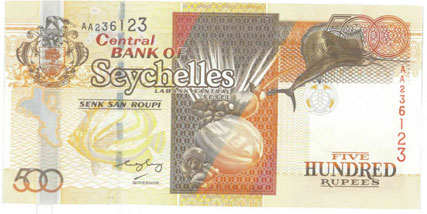

HOW EXTENSIVE WAS VOTER BRIBERY IN OUR PRESIDENTIAL ELECTION?
Woman arrested over voter bribery – says Nation
No, this headline was not here in
Here in
Although no one is starving to death here in

Was the R500 note the money of choice for bribing voters in our presidential election? At the time of the introduction of the R500 note in July last year, the Central Bank claimed that since 90% of the currency notes in circulation were in the form of one hundred rupee notes the country needed a higher denomination note.
No one knew this was a problem for the Joe and Jane public. Why not a R200 note? Or R300? There was no public debate so Mr Chang Leng did not have to justify the rationale behind the decision. In any event, we got to know about it only after the notes had been ordered from
According to Central Bank’s own statistics the total amount of currency notes in circulation as at 30 June, 2006 has reached the unprecedented level of SR 392,000,000 million rupees an increase of R92,000,000 compared to August 2005. So instead of replacing the R100 rupee notes, the higher denomination notes have, it seems, actually supplemented them. Surely there is something strange here?
Most interestingly, however, while the increase in the amount of notes in circulation between August to December 2005 was R48 million, the increase between 1st June and 31st July, 2006 alone was R44,000,000. In June 2006 alone, the value of notes and coins increased by R21,000,000 while for July it increased by R14,000,000.
Divided by the 30,000 voters the R92,000,000 in notes since August 2005 gives us a staggering R 3,000 per voter or R 9,200 per household of three voters? And when divided by fewer households – assuming only say 10,000 voters needed to be bribed (or 3000 households) the figure per person or per household becomes even more staggering. That is not to say, however, that Mr Michel bribed voters to vote for him.
But the R500 note was supposed to replace some of the R100 notes previously in circulation instead not to add to the 2,700,000 one hundred rupee notes already in circulation at that time, according to the Central Bank Governor. But how many R100 notes are in circulation; that is a question we plan to ask Mr Chang Leng.
Meanwhile, however, we have made our own unscientific survey of the serial numbers of 50 five hundred rupee notes and found the highest denomination to be 235,000. In countries where transparency is the norm this information would be in the public domain.